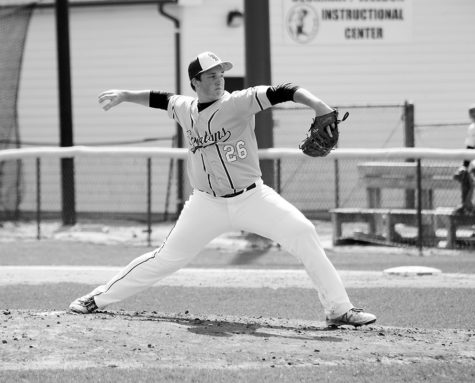IHSA introduces new pitch limit rule

Despite feelings of irritation in his arm his sophomore year, junior Brian McDevitt fought through the discomfort to prove himself worthy for the varsity team. He did not know that the irritation was really the beginning of a disease that would prevent him from playing for nearly the entire season.
“I thought it was just soreness, but then it started to happen consistently,” said McDevitt. “So, I saw a doctor [who] specifically works with baseball players, and he told me I have tendonitis.”
To prevent injuries, such as tendonitis, a new rule was put in place by the IHSA at the beginning of the 2017 baseball season that limits varsity high school pitchers to 105 pitches per game and lower level players to 95 pitches per game. The rule also institutes a set amount of rest days for pitchers, which varies based on the amount of pitches thrown. During a phone interview, Sam Knox, IHSA assistant executive director, said, “The main purpose of [the limit] is to guide pitchers and protect their health and their safety and their arms because, nationwide, the trend is that pitchers are developing more arm injures at a younger age, and so the national federation made the rules [in order] to cut down on the number of arm injuries.”
Only official pitches in live competition count toward the limit. If a pitcher reaches the limit in the middle of an at-bat, the pitcher can finish the at-bat, Knox said.
To keep track of pitches, the IHSA has developed an online pitch count tracking device accessible from the IHSA website. Coaches can submit the number of pitches their players threw and the device will tell them how many pitches each player will be allowed to throw in upcoming games.
If a team intentionally uses an illegitimate pitcher in a game, that team will have to forfeit the game. The coach of the opposing team can view the rest schedule of the opposing team’s pitchers to ensure that only eligible pitchers are playing.
Baseball Head Coach Dominic Savino said he does not think the new rule will affect the team’s season very much because the main pitchers only start one game a week, giving them plenty of time to recover between games.
“We just feel like if you’re trying to bring a pitcher back twice in the same week, at some point he’s going to break down, and we want our pitchers to be at their best at the end of the season, not at the start of the season,” Savino said.
The baseball program takes many measures, such as the preseason strength and conditioning program, to protect its pitchers’ arms, according to Savino.
“It’s not just a matter of protecting the shoulder, or preparing the elbow, it’s a matter of preparing the entire body,” said Savino. “If you prepare the entire body, then you can have the shoulder and the elbow start to be able to handle the forces that ultimately get applied when you pitch.”
McDevitt said he is now pitching this season and thinks that the pitch limit will be beneficial to athletes overall.
“I think it’ll be helpful for reducing injuries … and giving more guys playing time,” said McDevitt. “It’ll be a problem for teams that don’t have [many strong pitchers] because they’re going to run out of pitchers, and then they’ll have to throw guys that don’t really pitch.”
Although he injured his arm on four separate occasions, junior Isaac Weinberg said he does not think the rule should have been put in place.
“If a pitcher’s arm is hurting, he should know,” said Weinberg. “It shouldn’t be a rule that’s telling him, ‘Hey, after 75 pitches, or whatever [the limit] may be, your arm is going to hurt.’ It should be [at] the player’s discretion.”
According to Savino, players should tell their coaches immediately when they think they should be taken out of a game.
“[The players are] the only ones who know how their arm feels,” said Savino. “Nobody else knows exactly how their [arms feel].”

